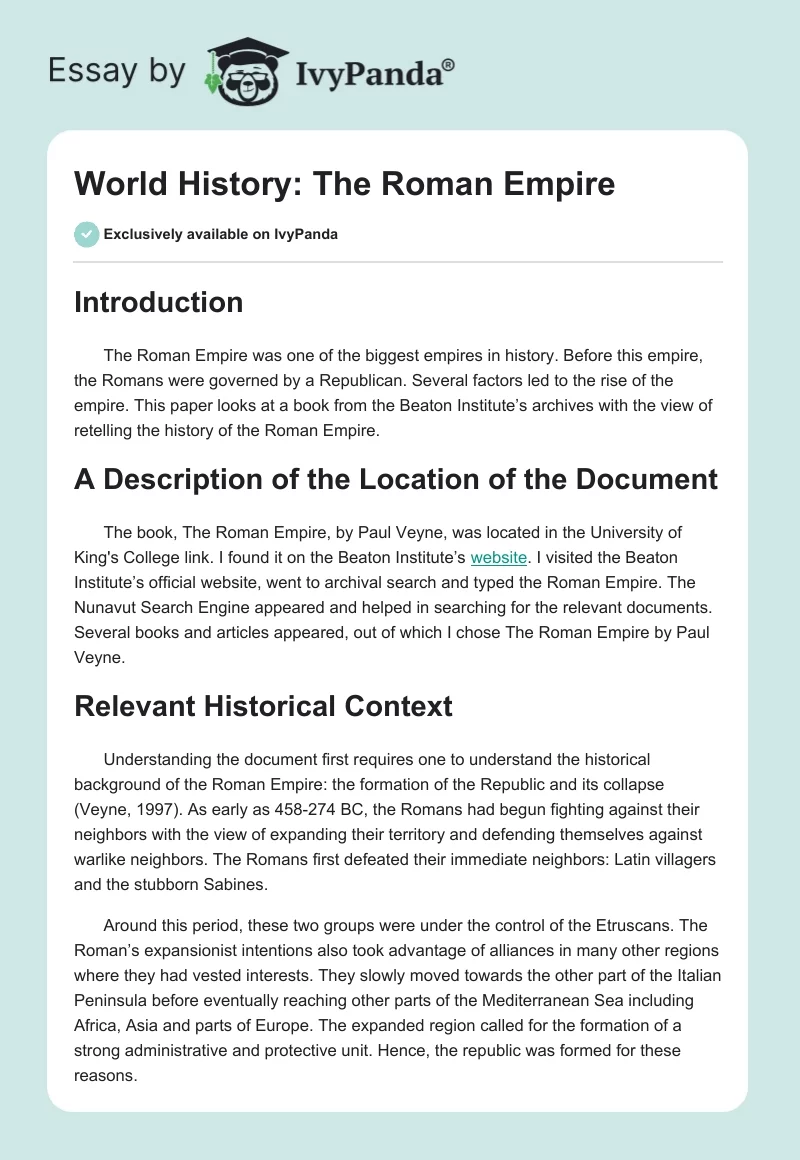Introduction
The Roman Empire was one of the biggest empires in history. Before this empire, the Romans were governed by a Republican. Several factors led to the rise of the empire. This paper looks at a book from the Beaton Institute’s archives with the view of retelling the history of the Roman Empire.
A Description of the Location of the Document
The book, The Roman Empire, by Paul Veyne, was located in the University of King’s College link. I found it on the Beaton Institute’s website. I visited the Beaton Institute’s official website, went to archival search and typed the Roman Empire. The Nunavut Search Engine appeared and helped in searching for the relevant documents. Several books and articles appeared, out of which I chose The Roman Empire by Paul Veyne.
Relevant Historical Context
Understanding the document first requires one to understand the historical background of the Roman Empire: the formation of the Republic and its collapse (Veyne, 1997). As early as 458-274 BC, the Romans had begun fighting against their neighbors with the view of expanding their territory and defending themselves against warlike neighbors. The Romans first defeated their immediate neighbors: Latin villagers and the stubborn Sabines.
Around this period, these two groups were under the control of the Etruscans. The Roman’s expansionist intentions also took advantage of alliances in many other regions where they had vested interests. They slowly moved towards the other part of the Italian Peninsula before eventually reaching other parts of the Mediterranean Sea including Africa, Asia and parts of Europe. The expanded region called for the formation of a strong administrative and protective unit. Hence, the republic was formed for these reasons.
The republic lasted for 500 years. It came to an end when Octavian was given extreme powers as the head of the Roman Empire and officially given the title, Augustus (Veyne, 1997).
He vowed to avenge the death of his adoptive father, Julius Cesar who was installed as the everlasting dictator of the Roman Empire, but later assassinated in 44 BC by Cassius and Brutus. The civil wars continued after Cesar’s death and Octavian won them and was formally given all-encompassing powers in 27 BC. He brought much stability to the empire. No such peace had been experienced in the region before.
The period of tranquility lasted for two centuries. After this period, there followed a period dominated by assassinations, suicides and civil wars (Veyne, 1997). The Senate contemplated re-introducing the republic but installed another emperor to continue with the leadership. The empire sailed through very many of such difficulties before eventually succumbing to the Ottoman Turks in the year 1453.
Critical Analysis of the Document
This document contributes to the understanding of the Roman Empire. It gives enough information regarding the events that gave rise to the establishment of the empire and the specific activities that both the leaders and their subjects did in order to achieve their intentions to expand and defend their territory.
It specifically points at the need for expansion and defense for the rise of the empire. According to Veyne (1997), the Romans faced many threats from their neighbors and had to stand up and defend their territory from being invaded by Latin villagers and Sabines. They also had to expand the region they occupied in order to secure themselves from future attacks.
The book also reveals that the murder of Cesar was orchestrated by the people around him. His killers were led by Gaius Cassius and Brutus, who were senators expected to help him in the running of the republic. On the contrary, they decided to stub him after he was declared dictator perpetuo in 44 BC (Veyne, 1997). The senators were afraid of what he would do if he took the powers bestowed upon him. They called themselves the liberators because they wanted to terminate the Senate’s plan to give Caesar more powers.
At the same time, the document reveals Augustus’ leadership skills. It portrays him as the strongest of all the Roman leaders (Veyne, 1997). He was neither preceded nor succeeded by any leader that achieved more than what he achieved as emperor.
The empire experienced more peace and development during his reign compared to any other period in the history of the existence of the Roman Empire. They fought very few wars, yet their army was at its best. This period paved the way for the stability that later followed. It took more than one thousand years for the enemies of the Roman Empire to succeed in subduing them.
Conclusion
This document is a very important historical record of the Roman Empire. It narrates everything about the empire: how it rose to prominence, why it took long to collapse, and what finally led to its collapse. It reports that the empire was established in the period that preceded the collapse of the Republic: after the assassination of Julius Cesar in 44 BC. It also reports that the period of Emperor Augustus was the most tranquil and experienced more development that any other period.
Reference
Veyne, P. (1997). The Roman Empire. Cambridge, MA.: Belknap Press of Harvard University Press.


